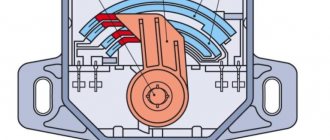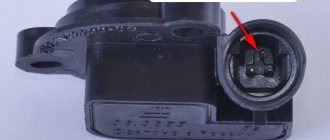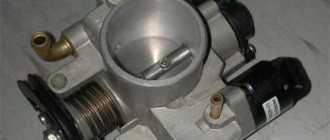Checking the throttle position sensor (TPS) VAZ 2110
We will talk about methods for diagnosing the throttle position sensor (TPS) of the VAZ 2110.
A device such as the throttle position sensor of the VAZ 2110 is a potentiometer that transmits information about the position of the throttle valve to the controller. The throttle position depends on the pressure on the gas pedal. At the output of the throttle position sensor there is a constantly changing voltage, which is monitored by the controller and, based on the data received, determines the fuel dose. If the TPS is faulty, the controller will receive distorted information. This will lead to excessive fuel consumption and engine interruptions.
The TPS is located in the engine compartment directly on the throttle pipe. It connects to the remote sensing axis.
Why is it better to buy a contactless TPS
The factory equipment of the VAZ 2110 provides for the installation of a conventional film-resistive throttle position sensor. The main reason for this preference is the low price of the sensor. Non-contact TPS models are considered a more expensive, but also reliable alternative. In the latter case, the operation of the sensor is based on the magnetoresistive effect, which reduces wear of parts and significantly extends the service life of the TPS.
Contactless TPS is expensive, but reliable
Why is it needed?
The throttle position sensor is responsible for determining the current throttle position. Depending on this, the fuel supply system changes the amount of fuel supplied under one or another operating mode of the power unit.
If problems arise with it, you can contact a service station so as not to waste your energy and nerves. But in practice, changing the TPS yourself is quite simple, plus you will save a decent amount of money.
The desired regulator is located on the side of the throttle pipe on the throttle valve axis.
Regulator location
Features of work
The TPS is essentially a variable resistor, one output of which is supplied with 5 Volt power. The second contact is connected to ground, and the third is connected to the controller.
When you press the gas pedal, the voltage changes. The sensor monitors the output voltage on the controller, thereby regulating and monitoring the quality of the supplied air-fuel mixture. This directly depends on the opening angle of the damper itself.
If for some reason this regulator fails, a catastrophe will not occur, since another sensor, the mass air flow sensor, will temporarily take over its functions.
This does not mean at all that the TPS can not be changed. Each regulator has its own functions, so there is no point in transferring the tasks of the TPS to the MAF.
Replacement
In fact, changing this sensor is insanely easy. So don't rush to send your car to a service station. Everything can be done with your own hands, the quality will not suffer from this.
- To remove the throttle position sensor, you first need to find it.
- As we have already noted, the desired unit is located on the side of the throttle pipe on the throttle valve axis.
- Having found the element, pick up a shaped screwdriver.
- Using this simple tool, unscrew a couple of bolts that hold the device.
- Pay special attention to the gasket that is available under the old regulator. We do not recommend using it again; it is better to immediately buy a new one. Often the gasket is already included with the throttle sensor itself.
- After removing the old sensor, you can slightly clean the place where it is installed if there is dirt there.
- Next, a new sensor is installed along with a new foam gasket and the bolts are tightened.
- Try to tighten the fasteners as far as possible, otherwise the new throttle sensor will quickly lose its effectiveness. The work will have to be done again.
- There is no need to make any adjustments after replacement.
- The zero mark on the controller will determine that the throttle is completely closed.
Foam pad
Evidence of pollution
Don't forget that the throttle valve can become dirty. Signs of this are the following criteria: the engine begins to stall, lose speed, the engine starts with difficulty, at the minimum speed of the car, jerking begins. Always check the throttle assembly for causes of problems. Damper contamination occurs in many cases. Settlement occurs on the walls of the mechanism, entering the assembly due to ventilation of gases. Another reason is poor filter performance.
The VAZ 2114 starter does not turn - the main reasons
How to Determine a Malfunctioning Throttle Sensor
Checking the TPS itself is simple, and all you need is an electronic multimeter capable of measuring DC voltage. So, to check the TPS malfunction, you need to follow the algorithm below:
- Turn on the car's ignition.
- Disconnect the chip from the sensor contacts and use a multimeter to make sure that the sensor is receiving power. If there is power, continue checking. Otherwise, it is necessary to “ring” the supply wires in order to find the break point or another reason why the voltage to the sensor is not suitable.
- Set the negative probe of the multimeter to ground, and the positive probe to the output contact of the sensor, from which information goes to the electronic control unit.
- When the throttle is closed (corresponds to the accelerator pedal being fully depressed), the voltage at the sensor output contact should not exceed 0.7 Volts. If you open the throttle completely (fully depress the accelerator pedal), then the corresponding value should be at least 4 Volts.
- Next, you need to manually open the damper (rotate the sector) and at the same time monitor the multimeter readings. They should rise smoothly. If the corresponding value rises abruptly, this indicates that there are worn spots in the resistive tracks, and such a sensor must be replaced with a new one.
Owners of domestic VAZs are often faced with the problem of TPS malfunction due to the poor quality of the wires (in particular, their insulation) with which these cars are standardly equipped from the factory. Therefore, it is recommended to replace them with higher quality ones, for example, produced by PES/SKK CJSC.
And, of course, it is necessary to perform a check using the OBDII diagnostic tool. A popular scanner that works with most cars is Scan Tool Pro Black Edition . It will help you find out exactly the error number and see the operating parameters of the throttle valve, and will also determine whether the car still has problems, possibly in other systems.
The most common error associated with the throttle position sensor is code P0120 and stands for “Throttle position/pedal position sensor/switch “A” circuit malfunction.” Another possible error p2135 is called “Mismatch of readings from sensors No. 1 and No. 2 of the throttle position.” The following codes may also indicate incorrect operation of the remote control or its sensor: P0120, P0122, P0123, P0220, P0223, P0222. After replacing the sensor with a new one, it is necessary to erase the error information from the ECU memory.
In the diagnostic application, the scanner will make it possible to see the data coming from the sensor in real time. When moving the damper, you need to look at the readings in volts and the percentage of its opening. If the damper is in good condition, the sensor should produce smooth values (without any jumps) from 03 to 4.7V or 0 - 100% with the damper fully closed or open. It is most convenient to view the operation of the TPS in graphical form. Sharp dips will indicate wear of the resistive layer on the sensor tracks.
Device malfunctions in the VAZ-2110
There are several typical signs of malfunctions, thanks to which it is possible to identify that problems have arisen with the TPS:
- high idle values;
- the engine cannot stall when the speed is turned off;
- the car jerks, there are jerks when picking up speed;
- acceleration dynamics are noticeably reduced;
- At idle the speed fluctuates.
Note. These signs can also be distinctive when other components fail - the IAC or the ignition module. Therefore, it is necessary to first investigate the TPS.
Possible faults
The contact-type sensor is quite reliable, and according to the designers’ plans, it should last at least 50,000 km. This is ideal under average operating conditions. In practice, it often fails before reaching half of its intended lifespan. Like any mechanics, the controller is very demanding regarding various clearances, frequency and speed of movement of the slider. The situation is complicated by the difficulty of diagnosis. The main symptoms of a malfunction of the VAZ-2110 throttle sensor are very similar to damage to many other components of the car. However, symptoms of TSD damage may include the following:
- deterioration of engine dynamic characteristics;
- jerking during intense acceleration;
- stopping the engine when changing gears;
- “dips” when sharply pressing the gas pedal.
As already noted, the weak point of the TPS is the mechanical moving contact. The resistor slider, moving across the resistive layer, damages it. The thin coating simply rubs off, the contact deteriorates, making further operation of the car problematic. In addition, the moving contact itself may break. In this case, the engine almost does not respond to the gas pedal.
In any case, the TPS cannot be repaired, and there is no point in restoring it. The price of the sensor does not exceed 300 rubles. True, first of all, you need to make sure that it is he who is faulty.
Signs of a malfunction of the TPS
If the VAZ 2110 DPS is broken, the following signs of its breakdown appear on the car:
- Increased speed XX;
- Spontaneous increase in speed when starting up to 2500 rpm;
- The car stalls on its own when you release the gas pedal;
- Fuel consumption increases;
- Engine power is lost;
- Starting the engine becomes more difficult;
VAZ 2110 checking DPD with a multimeter
Owners of VAZ-2110 cars often have to repair their vehicle. And the consequence of repair work can be both significant breakdowns and minor malfunctions. What type of failure is a malfunction of the throttle position sensor? What is this part responsible for in a car? How can we determine that this particular part is no longer functioning correctly? Read about it in our article.
WHAT IS TPS IN THE VAZ-2110 CAR
The throttle position sensor is abbreviated as TPS among motorists. This part is used in several types of engines:
- Gasoline injection type.
- Single injection type.
- Diesel engines.
TPS is also known as a throttle valve potentiometer. This is due to the fact that the sensor is designed to function as a variable resistor. The sensor itself is installed in the engine compartment - the place of fixation is the throttle pipe. The mechanism of operation of the sensor is as follows: depending on the position and degree of opening of the throttle valve, the resistance also changes. That is, the level of the value of such resistance depends on the pressing of the gas pedal. If the pedal is not pressed, the throttle valve will be closed and the resistance will be minimal. The opposite is true when the damper is open. Accordingly, the voltage across the TPS, which is directly proportional to the resistance, will also change.
The control of such changes is carried out by the electronic control system; it is the one that receives all signals from the TPS and supplies fuel using the fuel system.
So, at the maximum voltage of the signal contact of the throttle position sensor, the fuel system of the VAZ-2110 car will supply the largest portion of fuel.
Thus, the more accurate the TPS indicators, the better the VAZ-2110 electronic system adjusts the engine to the correct operating mode.
CONNECTION OF THE THROTTLE VALVE WITH OTHER VAZ-2110 VEHICLE SYSTEMS
The throttle valve of a VAZ-2110 car is a component of the engine intake system and is directly connected to a large number of other vehicle systems. These include the following systems:
- directional stability;
- anti-blocking;
- anti-slip;
- anti-slip;
- cruise control.
In addition, there are those systems that are controlled by the electronics of the gearbox. After all, it is this throttle valve that regulates the flow of air into the car system and is responsible for the quality composition of the fuel-air mixture.
DESIGN OF TPS
The throttle position sensor can be of two types:
- film;
- magnetic or contactless.
In its design, it resembles an air valve - in the open position the pressure corresponds to atmospheric pressure, in the closed position it drops to a vacuum state. The TPS includes DC and AC resistors (each resistance is 8 ohms). The process of opening and closing the damper is monitored by the controller, with subsequent adjustment of the fuel supply.
Principle of operation
The movable contact of the sensor is located on the same axis as the throttle valve. Its control sector is connected by a cable and rods to the gas pedal of the car. Thus, each press on the accelerator leads not only to the rotation of the damper at a certain angle, but also to the movement of the movable contact along the resistive coating. As a result, the resistance of the potentiometer changes and, as a result, the voltage at the corresponding terminal of the control unit. The ECU increases the amount of fuel supplied to the cylinders. Moreover, this will happen simultaneously with the opening of the throttle valve. Both events are synchronized in time, and the mixture that is optimal at the moment enters the cylinders. Therefore, any malfunction of the VAZ-2110 throttle sensor leads to depletion or enrichment of the composition, which makes the trip, to put it mildly, uncomfortable.
Causes of malfunction of the VAZ 2110 TPS
Reducing the base layer at the beginning of the slider stroke is one of the most common causes of failure of this sensor. This phenomenon prevents the output voltage from ramping up.
In addition, the TPS may fail due to a malfunction of the moving core. If one of the tips is damaged, it leads to the appearance of multiple scuffs on the substrate, as a result of which other tips also fail. Contact between the slider and the resistive layer is lost.
TPS problems and their diagnosis
As you know, eternal parts for cars have not yet been invented. And the breakdown of the TPS can be foreseen; for this you need to inquire about the possible reasons for the failure of this part. Here are the main ones:
- Abrasion of the sprayed base layer, which serves to move the slider (the result is incorrect TPS readings).
- Failure of the movable type core (the result is deterioration of the contacts between the slider and the resistive layer).
How can you figure out problems with this sensor yourself? To do this, you can independently diagnose the operation of your diagnostics:
- Listen to the VAZ-2110 engine idling:
- the breakdown is obvious if you notice that its speed is in a “floating” state;
- Quickly release the gas pedal:
- a malfunction is present if the engine stops after this action.
- Pick up speed:
- There is a problem with the TPS if the car starts to move jerkily, which indicates an incorrect supply of fuel to the system.
Experts say that most often the sensor fails when the resistive track is heavily contaminated or is completely broken. To verify the opposite, you need to check the working condition of the TPS.
Regulator condition: check on VAZ-2110
So how do you test your throttle sensor? This process is necessary, as it makes it possible to understand whether the malfunction is actually due to its cause or the problem is due to the failure of other parts of your “ten”.
Sometimes new car owners make hasty conclusions based on the primary signs of damage. This entails extra spending of money and time on repairs.
To check the current TPS position, you will need to do the following:
- measure the voltage at the output of the slider, while turning on the ignition, open the idle contacts;
- during the test it showed a voltage above 0.7 V - which means the controller is faulty;
- open the throttle valve completely (in normal position the voltage values are a maximum of 4 V);
- measure the variable resistor for resistance;
- connect an ohmmeter/multimeter to the power supply and output;
- slowly turn the valve;
- track readings on the device;
- if the resistance changes smoothly as the damper opens, then the device is functioning properly.
If during the inspection you notice that the TPS itself is damaged, it will need to be replaced. Repair will not help here. An important point is the selection of this element. In the 2110th VAZ model, 2 analogues of TPS are installed:
- Film resistive. This type is equipped by the manufacturer; The sensor is designed for 55 thousand km.
- Contactless. A Hall sensor is used here. Such a device has no restrictions regarding its service life. The cost of such a sensor is more expensive.
The resistive layer, where the slider moves, wears out over time when exposed to friction. For this reason, the regulator produces incorrect data, the properties of the supplied mixture change, and engine performance decreases.
HOW TO CHECK ITS WORK INDEPENDENTLY
You already know the signs of a malfunctioning throttle position sensor, let's try to check its functionality ourselves. A sequenced test cycle will help you check how to check the throttle position sensor. To perform this, you need to have a tester, a multimeter or a simple voltmeter with a scale of 15-20 volts.
The verification procedure will be as follows:
- You need to open the hood and find the TPS. Look for it near the throttle valve;
- To check, a connector from this sensor is required, so it is disconnected from the TPS;
- Now a voltmeter or other devices are connected to work in voltage measurement mode. The “minus” of the device is connected to the “ground” of the car, and the voltage will be checked with the second probe. Carefully examine the connector body and find the terminal marked with the letter “A”.
- With the ignition on, check for voltage at this terminal. It should be equal to 5 volts. If there is power, then the TPS is out of order and must be repaired or replaced. If the voltage is significantly lower than 5 volts or is absent at all, it is necessary to check the entire electrical circuit of its power supply. If everything is fine with it, the controller may fail.
You can check the operation without disconnecting the connector from the TPS. Let's look at this technique in action, how to check the TPS without disconnecting it from the power supply. The purpose of the test remains the same, this is to check the presence of supply voltage at the TPS. With the ignition on and a voltmeter connected, the device should show a smooth voltage change from 0.7 to 4 V if you smoothly turn the plastic throttle sector. The TPS connector must be connected, and the supply voltage is checked by calcining the wire with the probe of the measuring device.
If you have an ohmmeter, you can check the resistance of the sensor potentiometer. In this case, the connector is disconnected from the TPS, and the ohmmeter probes must be connected to any fixed and moving contacts. When the sector rotates, the meter needle should move smoothly. Jerking or jerking movement of the instrument needle is evidence of its malfunction.
It makes no sense to repair it, since the reasons for the malfunction of the VAZ 2114 TPS almost always lie in the breakage of the conductive layer. Easier to replace with a new one.
Manufacturers guarantee its normal operation for approximately 50 thousand kilometers. Currently, TPS from the city of Kaluga have appeared. They are a contactless device that does not have a moving slide, and the contact does not wear out. The service life of such a device is unlimited.
When the TPS on a car is being replaced, this is a favorable moment to repair the throttle valve. Repair will be said loudly, since in most cases everything is limited to cleaning and washing this unit.
Use any liquid to clean carburetors, do not miss a single channel when cleaning and everything will work out.
Sometimes the question arises about how to test a new throttle position sensor. This can be done using an ohmometer as described above.
Procedure for replacing the sensor
To get the job done, you only need a medium sized screwdriver. The sequence of actions is as follows:
- Disconnect the block with wires from the sensor.
- Unscrew the two mounting screws.
- Remove the sensor.
- Replace the foam pad.
- Install a new sensor.
- Connect the electrical block.
Thus, replacing the TPS yourself does not pose any problem, although there is one “but”. The sensor is tested by the vehicle's on-board computer. In the event of a malfunction, the “Check engine” is turned on. So, even after installing a new TPS, the alarm will not go off. You will have to disconnect the battery terminal for 15 minutes or reset the error in another available way.
Sensor check
The controller is an electronic element, and its operation can only be verified with special devices. Therefore, before checking the VAZ 2110 throttle sensor, you need to gain at least minimal skills in using a multimeter. This is not so difficult, especially since you only need to know two modes: measuring resistance and voltage.
So, to check the TPS voltage, you need
- Using a multimeter probe, without removing the block, measure the voltage between ground and the moving contact of the potentiometer, with the throttle valve closed.
- The device readings should not differ greatly from 0.7 V.
- Now you need to press the pedal all the way.
- The voltage should be higher than 4V.
- Turn off the ignition.
If even in one case, the multimeter readings do not correspond to the norm, this is a sure sign of a malfunction of the VAZ 2110 throttle sensor.
The voltage may be within the nominal values. This means that the resistive element is working, but there may be no contact between the coating and the moving contact. This is determined by measuring the resistance. You need to remove the wire block from the sensor and place the probes of the multimeter on the central and any of the outer contacts. Smoothly press the accelerator pedal. The instrument readings should change without jerks or dropouts. For better information content, you should use a pointer device.











